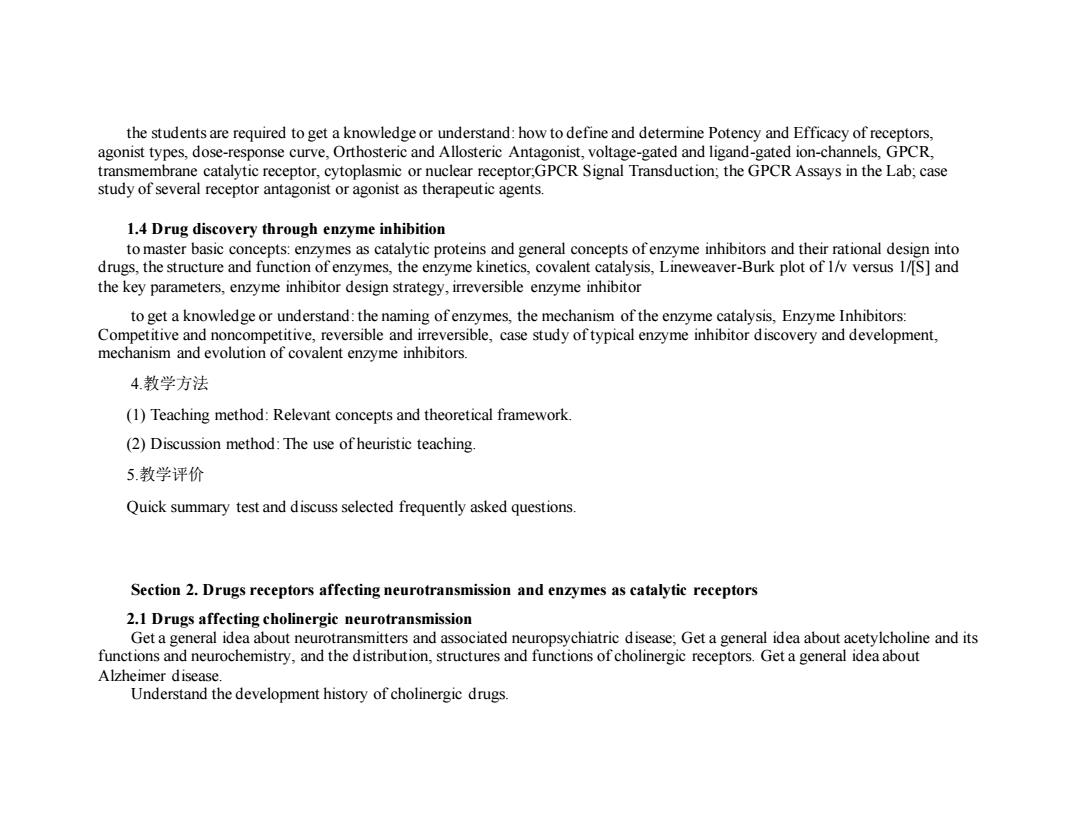正在加载图片...

the students are required to get a knowledge or understand:how to define and determine Potency and Efficacy of receptors, agonist types,dose-response curve,Orthosteric and Allosteric Antagonist,voltage-gated and ligand-gated ion-channels,GPCR, transmembrane catalytic receptor,cytoplasmic or nuclear receptor;GPCR Signal Transduction;the GPCR Assays in the Lab;case study of several receptor antagonist or agonist as therapeutic agents. 1.4 Drug discovery through enzyme inhibition to master basic concepts:enzymes as catalytic proteins and general concepts of enzyme inhibitors and their rational design into drugs,the structure and function of enzymes,the enzyme kinetics,covalent catalysis,Lineweaver-Burk plot of 1/v versus 1/[S]and the key parameters,enzyme inhibitor design strategy,irreversible enzyme inhibitor to get a knowledge or understand:the naming of enzymes,the mechanism of the enzyme catalysis,Enzyme Inhibitors: Competitive and noncompetitive,reversible and irreversible,case study of typical enzyme inhibitor discovery and development, mechanism and evolution of covalent enzyme inhibitors. 4.教学方法 (1)Teaching method:Relevant concepts and theoretical framework (2)Discussion method:The use of heuristic teaching. 5.教学评价 Quick summary test and discuss selected frequently asked questions. Section 2.Drugs receptors affecting neurotransmission and enzymes as catalytic receptors 2.1 Drugs affecting cholinergic neurotransmission Get a general idea about neurotransmitters and associated neuropsychiatric disease;Get a general idea about acetylcholine and its functions and neurochemistry,and the distribution,structures and functions of cholinergic receptors.Get a general idea about Alzheimer disease. Understand the development history of cholinergic drugs.the students are required to get a knowledge or understand: how to define and determine Potency and Efficacy of receptors, agonist types, dose-response curve, Orthosteric and Allosteric Antagonist, voltage-gated and ligand-gated ion-channels, GPCR, transmembrane catalytic receptor, cytoplasmic or nuclear receptor;GPCR Signal Transduction; the GPCR Assays in the Lab; case study of several receptor antagonist or agonist as therapeutic agents. 1.4 Drug discovery through enzyme inhibition to master basic concepts: enzymes as catalytic proteins and general concepts of enzyme inhibitors and their rational design into drugs, the structure and function of enzymes, the enzyme kinetics, covalent catalysis, Lineweaver-Burk plot of 1/v versus 1/[S] and the key parameters, enzyme inhibitor design strategy, irreversible enzyme inhibitor to get a knowledge or understand: the naming of enzymes, the mechanism of the enzyme catalysis, Enzyme Inhibitors: Competitive and noncompetitive, reversible and irreversible, case study of typical enzyme inhibitor discovery and development, mechanism and evolution of covalent enzyme inhibitors. 4.教学方法 (1) Teaching method: Relevant concepts and theoretical framework. (2) Discussion method: The use of heuristic teaching. 5.教学评价 Quick summary test and discuss selected frequently asked questions. Section 2. Drugs receptors affecting neurotransmission and enzymes as catalytic receptors 2.1 Drugs affecting cholinergic neurotransmission Get a general idea about neurotransmitters and associated neuropsychiatric disease; Get a general idea about acetylcholine and its functions and neurochemistry, and the distribution, structures and functions of cholinergic receptors. Get a general idea about Alzheimer disease. Understand the development history of cholinergic drugs